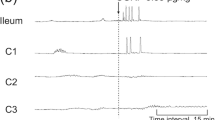2
α (PGF) and cisapride were investigated during the early postoperative period in 26 patients who underwent abdominal surgery. Records of intestinal motility were made using an infusion catheter. PGF, 0.4 μg/kg per minute, given intravenously over 60 min, and cisapride, 5 mg, given intraintestinally, were administered to 13 patients each, first immediately after the operation, and then after the migrating motor complexes (MMCs) had reappeared following a period of intestinal quiescence. The MMCs were reestablished within the first postoperative day. Both PGF and cisapride stimulated irregular, high-amplitude contractions; however, the MMCs reappeared following these induced contractions only if the drugs were administered just after the postoperative MMCs became evident. These prokinetic drugs did not affect gastrointestinal hormone concentrations, but induced contractile activity even in the early postoperative period. Although the findings of this study demonstrate that these drugs may be useful as prokinetic agents to promote recovery from postoperative ileus just after the reappearance of MMCs in the early postoperative period, their precise mode of action has not been established.
Similar content being viewed by others
Author information
Authors and Affiliations
Additional information
(Received for publication on May 7, 1997; accepted on Nov. 6, 1997)
Rights and permissions
About this article
Cite this article
Shibata, Y., Toyoda, S. Effects of Prostaglandin F2α and Cisapride on Small Intestinal Activity During the Early Postoperative Period in Humans. Surg Today 28, 787–791 (1998). https://doi.org/10.1007/s005950050227
Issue Date:
DOI: https://doi.org/10.1007/s005950050227




